
|
Today's Calendar |
| | Simply Economics |
| | International Perspective |
| | Resource Center |
 |
|
| 1999 Articles |
|
By Evelina M. Tainer Chief Economist, Econoday Employment situation creates ebullient mood in financial markets
The perversity of (Fed) talking heads 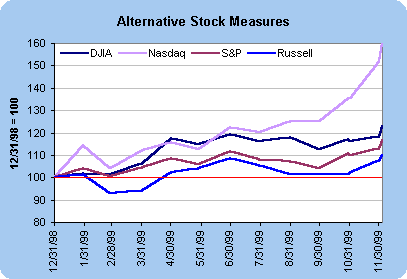 The most interesting market rally took place on Friday after the employment report. It seems that the stability of the jobless rate coupled with a modest gain in wages satisfied investors that the Fed would not raise interest rates suddenly this year. The most ironic part of this rally was that market players became "reassured" by the status quo - and a stronger than expected gain in nonfarm payrolls - because a Fed governor made a simple remark about the jobless rate. Larry Meyer indicated that the Fed might be forced to raise rates if the jobless rate decreased from its current level of 4.1 percent. The initial impact of the remarks was bearish on financial markets. And as the employment report came closer to its release date, investors became increasingly more nervous. By the time Friday rolled around and the Labor Department reported no change in the jobless rate, a rally was in the cards. No doubt, Mr. Meyer is now sorry he mentioned his worries about the jobless rate. The Fed will now be more concerned about the stock market zooming to stratospheric levels. Remember that the Fed is concerned about the "wealth effect" whereas consumers could spend more money because they feel wealthier as their stock portfolio appreciates. If Meyer hadn't stressed any particular interest in the jobless rate, the employment report wouldn't have looked so rosy to financial market participants. Now the NASDAQ composite reached a new high and the Dow (nearly) regained its previous peak.
Treasury yields are up despite Friday's rally 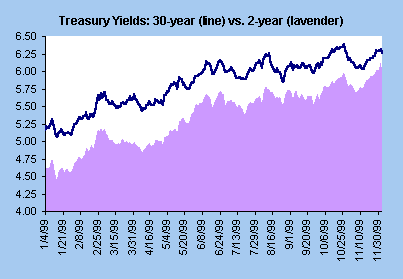
Jobless rate unchanged; wages stable; payrolls moderate 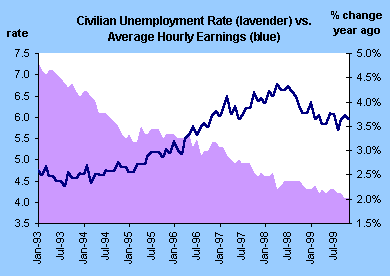 Nonfarm payroll employment rose 234,000 in November, just a bit more than predicted by economists, but following a downward revision to the previous month's data. On the whole, payroll gains are moderate even though the 3-month moving average of the series ticked higher in November. Looking at a longer-term trend in the chart below reveals a slight downward drift to average monthly changes in the past year. 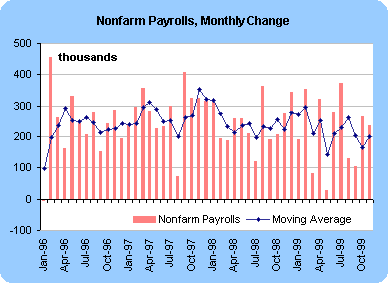 The composition of growth in payrolls was not unexpected. Service-producing industries saw the bulk of the gain in the business and health sector. Retail trade employment barely budged. But remember that it is tough to hire new employees for the holiday season in a robust economy that saw employment soar throughout the year. Among goods producing industries, construction employment jumped 55,000 - its largest monthly gain since February. It is interesting that two of the largest monthly gains occurred in months where the seasonal naturally expects slower growth. This means that construction is healthy, but perhaps not as robust as indicated by the actual number. Manufacturing remains the anemic cousin in this sector. Yet, given the improvement in factory orders over the past 12 months, one would have expected better employment gains in factories. The chart below shows the discrepancy that began about a year ago. This could reflect a variety of factors working together. For instance, productivity enhancements could alleviate the need for additional factory workers just at the time that labor markets are tight and skilled workers are hard to find. 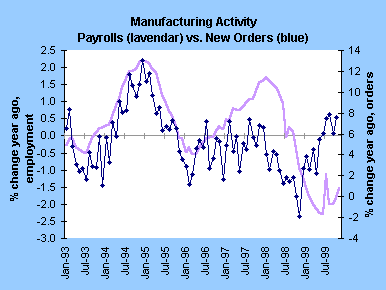 The bottom-line on the employment situation? Employment conditions remain favorable. Despite a low unemployment rate, wages are not accelerating. Clearly, average hourly earnings are the worst of all possible wage measures, but at least correlate with others that show relative stability recently. The low jobless rate is worrying Fed officials, but at 67 percent, the labor force participation rate is down from its peak of 67.4 percent, which it reached in January. This does leave some room for increased participation even if the pool of potential employees is not as large and available as the Fed chairman would like it to be. These figures don't really change the outlook for Fed policy in the near term. The Fed almost stated point blank (in their usual cloudy manner) that they weren't inclined to raise rates at the December 21 FOMC meeting. That does leave open the question of "bias."
Home sales plunge - no wait - they skyrocket?!? Sales of new and existing homes are substitutes. While it isn't always the case, it is generally true that existing homes are starter homes and lower-priced than new homes, which are higher priced and often for second (or third) time buyers. In any case, it is more realistic to look at the market for single family home sales in its entirety. To this end, the chart below reveals that home sales indeed peaked in June. Sales levels are high by historical standards, but drifting lower. 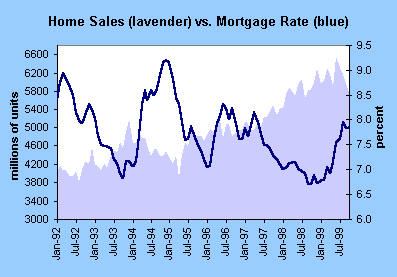 The bottom-line on home sales? Given the sharp disparity between new and existing home sales, it might be best not to draw a strong conclusion about the direction of this booming sector. Yet, the rise in mortgage rates over the past year (of more than one full percentage point) should eventually depress sales even in this sizzling economy. Even if home sales did peak this past summer, consumers will probably still find some reason to buy furniture and appliances for a few more months. A moderation in housing, though, will eventually trickle down to a slower rate of expenditure on consumer durable goods.
NAPM dips 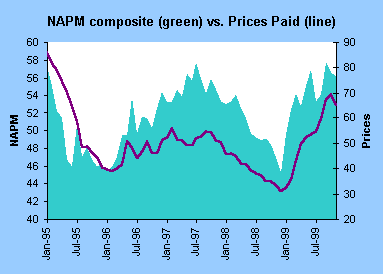 The bottom-line on manufacturing? The NAPM and factory orders still show that manufacturing activity is moving along at a moderate pace. Most analysts do believe that increased demand for exports will help propel manufacturing activity next year even as consumer spending is scaled back moderately.
THE BOTTOM LINE Most policy-makers stress that they need to be pre-emptive against inflationary pressures, but they seem to be willing to take a few chances in case a new economic paradigm has emerged in the past several years. Fed governor Larry Meyer is the most adamant opponent of the "new economy" stressing that some key economic relationships are indeed stable. Some of the question marks surround the NAIRU (non-inflationary rate of unemployment) and the potential for further productivity growth. The figures released this week aren't going to induce the Fed to raise rates at the December FOMC meeting just a few days before Year 2000. It is possible that they revert back to a "bias towards tightening" away from the current neutral stance. Most analysts do expect the Fed to raise rates next year. Analysts are mostly split between a February and a March rate hike.
Looking Ahead: Week of December 6 to December 10
Tuesday Economists are predicting that consumer installment credit could rise by $6 billion in October - reflecting healthy expenditures on consumer durables as well as regular retail spending. This would roughly match the September gain.
Wednesday
Thursday
Friday |
|||||||||||||||||||||||||||||||||||||||||||||||||||||||||||||||||||||||||||||||||||||||||||